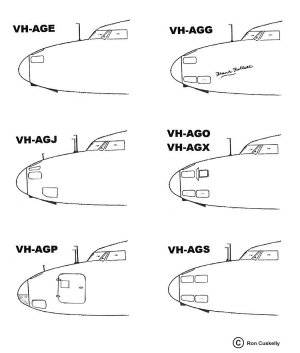HUDSON
PROBOSCISES
One of the most distinctive
features of the Hudson is its nose glazing configuration, yet only
one of Adastra's aeroplanes (VH-AGS) retained the classic four window
layout. None of the Adastra fleet retained the flat bomb-aiming transparency
under the nose. Throughout their careers, the Adastra Hudsons had
many changes in configuration, depending on whether they were used
for photographic or geophysical survey. All of Adastra's aircraft
(with the apparent exception of VH-AGP) had a camera aperture and
wind deflector on the underside of the nose compartment as well as
a drift sight installed immediately aft of the nose transparency.
This modification entailed relocating the pitot mast(s) to the top
of the nose, forward of the windscreen. Most Hudsons eventually carried
dual pitot masts in this position. Peculiarities to each Adastra Hudson
are as follows:
VH-AGE
When acquired from East-West Airlines this aeroplane had a "solid"
nose. The aircraft initially entered service with only a transparent
nose cone and no other windows. A single nose window in the top forward
position was later added.
See photo.
VH-AGG
This aeroplane was the only Adastra Hudson to carry a name, being
named "Frank Follett" in honour of the company's founder.
VH-AGJ
Acquired from Herald Flying Services, this aeroplane featured a rather
haphazard glazing configuration of varied shapes, with only the nose
transparency and the upper window being standard. Earlier in its survey
career as VH-SMM, this aeroplane featured a non-standard nose transparency
incorporating additional metal framing and framed flat windows top
and bottom. This was subsequently replaced with a standard Hudson
nose transparency. See Mike Mike's Nose
VH-AGO/VH-AGX
Apparently the only two Hudsons to have an identical nose glazing
configuration, these aircraft had a removable panel with a wind deflector
in the top aft position on the left side only, evidently for oblique
photography.
VH-AGP
This aeroplane retained its Lodestar type nose door from its days
as an airliner with East-West. This aircraft was modified for aerial
survey by East-West before being sold to Herald Flying Services. At
one stage of its career, the lower half of the nose transparency was
rendered semi-opaque.
VH-AGS
The only Adastra Hudson to retain the classic four windows was previously
East-West's flagship and featured a "solid" nose and a Lodestar type
nose door. In addition to repairing the aeroplane after its ground
running accident, Adastra removed the nose door, restored the conventional
nose glazing and converted the aircraft to Wright Cyclone engines!
The aeroplane now flies in wartime military configuration, complete
with turret.

Adastra Hudson Nose
Configurations.
[Click on image for a full screen view]
| 